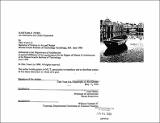Habitable piers : an alternative for urban expansion
Author(s)
Lin, Chin Yuan, M. Arch. Massachusetts Institute of Technology
DownloadFull printable version (13.13Mb)
Other Contributors
Massachusetts Institute of Technology. Department of Architecture.
Advisor
Imre Halasz.
Terms of use
Metadata
Show full item recordAbstract
This thesis is an investigation into an alternative way of urban expansion for a seaside community. This thesis proposes a habitable urban environment on the water by creating for an exchange between the built urban landscape and the water. The pier being the only element in between the land and the sea is the place where the urban life can extend into the water and where the sea can interact with the urban fabric. Provincetown MA is the site for this thesis. The ocean is the source of wealth of Provincetown, and indeed it was the harbor that gave birth to the town in the first place. The design is generated through a set of dimensions which is taken from the harbor and the greater landscape. Then an abstraction of the town's urban qualities is overlaid onto this set of dimensions to generate the overall design. Finally the building form and weather enclosures are a result of the conditions imposed by living on the water, the climate, and other physical characteristics of the site. The two central concerns of the thesis are piers and urbanism. The piers are about being on the water, at the zone of the exchange between the water and the land. Urbanism is about the additive process of collective building where discrete building decisions can add up to a block; and the blocks in tum add up to form the city.
Description
Thesis (M. Arch.)--Massachusetts Institute of Technology, Dept. of Architecture, 1990. Includes bibliographical references (p. 65-67).
Date issued
1990Department
Massachusetts Institute of Technology. Department of ArchitecturePublisher
Massachusetts Institute of Technology
Keywords
Architecture.